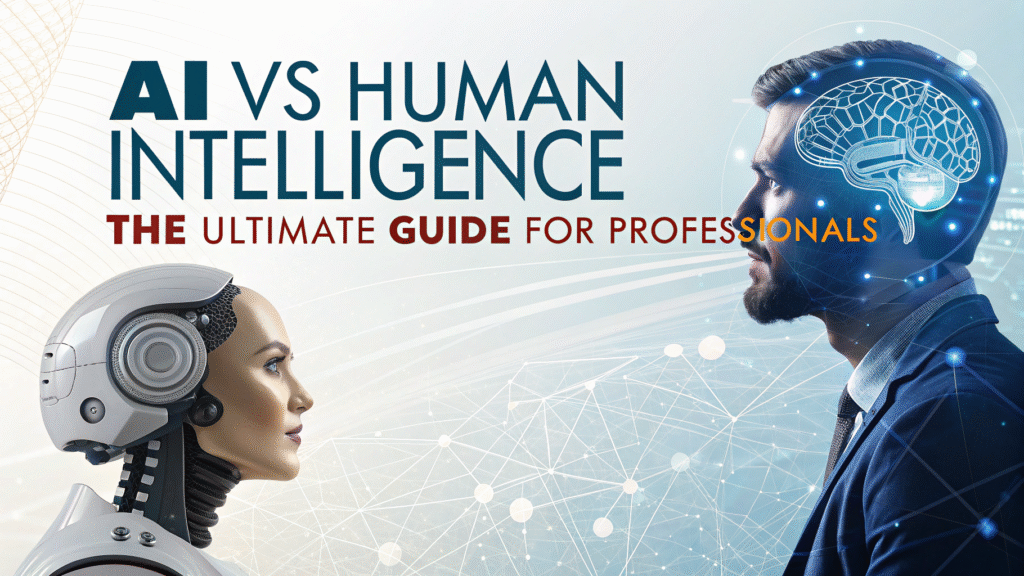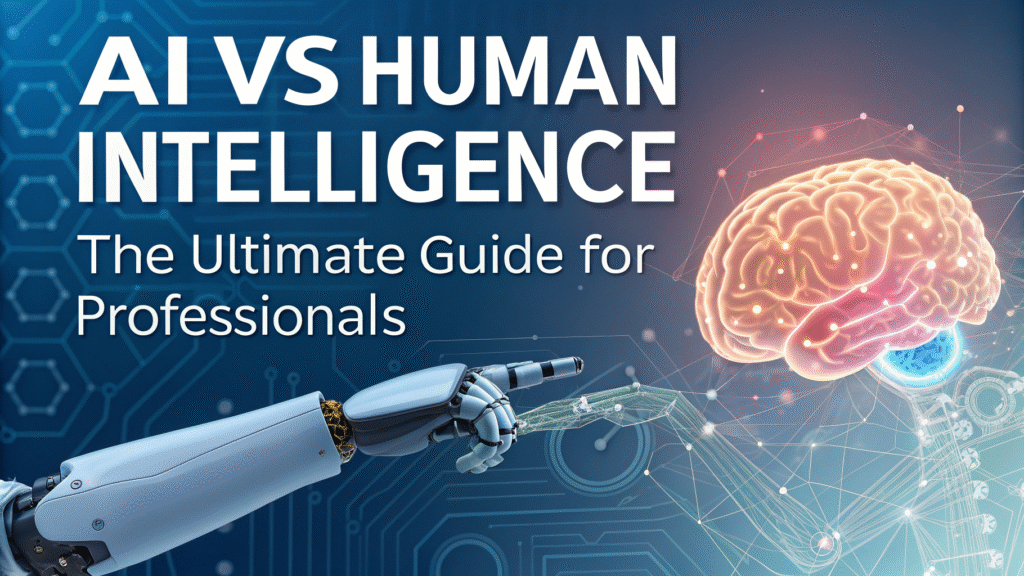
Introduction
The debate surrounding AI vs Human Intelligence is one of the most critical conversations for modern professionals. Is artificial intelligence poised to replace human workers, or is it the ultimate tool for augmentation? For entrepreneurs, marketers, and content creators, understanding this dynamic is no longer academic—it’s strategic. This guide moves beyond the hype to provide a clear-eyed analysis of the unique strengths and limitations of both. We will explore how the synergy between computational power and human intuition creates a formidable competitive advantage. Let’s dive into the ultimate guide for leveraging the partnership of AI vs Human Intelligence.
The History & Evolution of the Debate
The concept of artificial intelligence has evolved dramatically, shaping our understanding of human cognition in return.
- The Early Days (1950s-1980s): The field of AI was born, focused on symbolic reasoning and logic puzzles. The goal was to replicate human-like reasoning in a machine. Conversely, this period led psychologists to better map human problem-solving.
- The AI Winter & Rise of Machine Learning (1980s-2000s): Early optimism faded when AI struggled with real-world tasks. However, the shift to machine learning, where algorithms learn from data, marked a turning point. This contrasted sharply with human learning, which is often based on experience and intuition.
- The Deep Learning Revolution (2010s-Present): The explosion of data and computing power enabled neural networks to achieve superhuman performance in specific tasks like image recognition. This forced a refinement of the AI vs Human Intelligence debate, highlighting AI’s superiority in pattern recognition within vast datasets, while underscoring human strengths in general knowledge and adaptability.
Who Needs This Guide? Audience & Demographics
This discussion is particularly vital for roles that blend creativity, strategy, and data.
- Entrepreneurs & Business Leaders: Making strategic decisions about automation, workforce planning, and innovation.
- Marketers & Advertisers: Balancing data-driven campaign optimization with authentic brand storytelling and emotional connection.
- Content Creators & Designers: Using AI for ideation and production while ensuring output retains a unique, human voice and creative vision.
- Knowledge Workers & Analysts: Leveraging AI to process information while applying critical thinking and contextual understanding.
If your job requires balancing efficiency with empathy, data with creativity, then understanding AI vs Human Intelligence is essential.
Key Features & Functions: A Comparative Analysis
The most effective approach is to view AI and human intelligence not as rivals, but as partners with complementary skill sets.
Strengths of Artificial Intelligence
- Speed & Scale: AI can analyze millions of data points, generate hundreds of content variations, or scan thousands of legal documents in seconds.
- 24/7 Availability: AI systems operate continuously without fatigue, making them ideal for customer service chatbots and monitoring systems.
- Pattern Recognition: Excels at identifying complex correlations in large datasets that are invisible to the human eye.
- Objectivity & Consistency: AI is not influenced by emotions or biases (though it can inherit bias from its training data), ensuring consistent output.
Strengths of Human Intelligence
- Contextual Understanding: Humans grasp nuance, sarcasm, cultural subtleties, and unspoken rules that AI often misses.
- Emotional Intelligence (EQ): The ability to empathize, build trust, motivate teams, and understand customer emotions on a deep level.
- Creativity & Abstract Thinking: Generating truly novel ideas, thinking outside the dataset, and making imaginative leaps.
- Ethical Reasoning & Judgment: Making complex moral decisions, understanding the “why” behind a rule, and adapting to unforeseen circumstances.
Business & Marketing Potential of the Synergy
The real power lies in combining these strengths. The future of business belongs to those who can best orchestrate AI vs Human Intelligence as a collaborative force.
- Hyper-Personalized Marketing: Use AI to analyze customer data and segment audiences, then empower human marketers to craft emotionally resonant messages for each segment.
- Accelerated Innovation: Employ AI to simulate product designs or predict market trends, freeing human teams to focus on creative concepting and strategic implementation.
- Enhanced Decision-Making: Leverage AI to provide data-driven forecasts and risk analysis, while humans provide the final judgment based on experience, ethics, and long-term vision.
- Content at Scale with a Soul: AI can draft blog posts, social media captions, and video scripts based on SEO keywords. Human editors then inject brand voice, storytelling, and emotional depth.
Best Practices & Tips for Integration
Successfully blending AI and human intelligence requires a thoughtful strategy.
- Play to Their Strengths: Assign repetitive, data-intensive tasks to AI. Reserve strategic, creative, and empathetic tasks for humans.
- Establish a Feedback Loop: Create a system where human feedback continuously improves the AI’s output. For example, human editors can “train” a content AI on what constitutes good brand tone.
- Invest in Upskilling: Instead of fearing replacement, train your team to work alongside AI. Focus on developing skills like prompt engineering, data interpretation, and creative strategy.
- Maintain Human Oversight: Always have a human in the loop for final approval, especially for decisions with ethical implications or significant business impact.
Challenges & Limitations to Acknowledge
A balanced view requires acknowledging the hurdles in the AI vs Human Intelligence partnership.
- AI Bias: AI models can perpetuate and even amplify societal biases present in their training data, requiring vigilant human monitoring.
- The “Black Box” Problem: The decision-making process of complex AI can be opaque, making it difficult to understand “why” a certain output was generated.
- Human Resistance & Job Displacement Fears: Managing organizational change and addressing legitimate concerns about the future of work is a significant challenge.
- Over-reliance on Technology: There’s a risk of losing human skills and intuition if we delegate too much to automation.
The Future Outlook: Collaborative Intelligence
The trajectory is moving away from replacement and toward collaboration. We are entering an era of “collaborative intelligence.”
- AI as a Co-pilot: AI will become deeply integrated into software tools, acting as an intelligent assistant that suggests ideas, automates tasks, and provides insights in real-time.
- Focus on Uniquely Human Skills: As AI handles more analytical tasks, the value of creativity, empathy, and leadership will skyrocket in the job market.
- New Hybrid Roles: New professions will emerge, such as AI trainers, explainability experts, and automation ethicists, who bridge the gap between technical and human domains.

Conclusion
The narrative of AI vs Human Intelligence is ultimately counterproductive. The most successful professionals of 2025 and beyond will be those who reframe the question from “versus” to “and.” Artificial intelligence offers unparalleled speed, scale, and analytical power. Human intelligence provides irreplaceable context, creativity, and compassion. The ultimate guide is this: leverage AI to handle the heavy lifting of data, and focus your human energy on strategy, connection, and innovation. The future isn’t about choosing sides; it’s about combining strengths to achieve what neither can do alone.